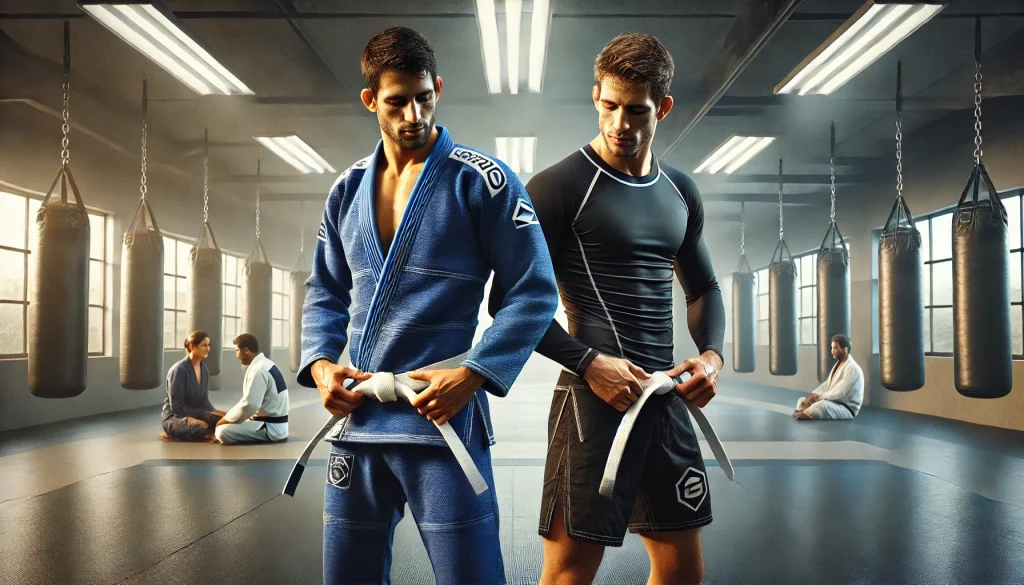
Why Beginners Should Start Brazilian Jiu-Jitsu in the Gi
Brazilian Jiu-Jitsu (BJJ) is practiced in two primary styles: gi and no-gi. Gi BJJ, which requires practitioners to wear a traditional uniform, involves using grips on the jacket, pants, and belt to control and submit an opponent. No-gi BJJ, on the other hand, uses a rash guard and shorts, focusing on controlling the body directly. While both styles have their place in a well-rounded BJJ practice, beginners benefit greatly from starting in the gi. In this article, we’ll explore why training in the gi provides a stronger technical foundation, improves understanding of control and escapes, and better prepares practitioners for real-life scenarios.
1. The Gi Slows Down the Game and Encourages Positional Control
One of the key advantages of training in the gi is that it naturally slows down the pace of rolling (sparring). Gi training allows for grips on the collar, sleeves, and pants, giving practitioners far more tools to control their opponent. This results in fewer chaotic scrambles and more emphasis on establishing and holding dominant positions.
In no-gi, the absence of grips often leads to more rapid, unpredictable movements and frequent scrambles. This high-paced environment, while exciting, can be overwhelming for beginners who are still learning how to control their own movements, let alone control an opponent’s. In the gi, beginners can take the time to properly establish control, learn to pin an opponent, and move around them methodically. By focusing on positional control, beginners develop a solid foundation, making them more effective grapplers in both gi and no-gi situations over time.
2. Building Skills in Pinning and Pressure
One of the most important aspects of BJJ is the concept of pressure, or the ability to control an opponent’s movement by using your weight and positioning. In the gi, grips on the collar, sleeves, and pants allow practitioners to better apply and maintain this pressure, which helps keep the opponent pinned down and reduces their ability to escape.
As a beginner, learning to control and pin an opponent is far more valuable than relying on explosive movements or “slippery” escapes. The gi gives beginners the chance to develop skills in holding down an opponent and passing their guard with precision rather than with speed or strength. Learning how to methodically control and pin someone not only builds confidence but also reinforces one of the key principles of BJJ: position before submission. By learning to stabilize positions, beginners avoid the temptation to jump from one position to another and instead focus on maintaining control, a skill that is critical as they advance.
3. Developing Technical Escapes
When it comes to escaping bad positions, gi training encourages technical precision over physicality. In no-gi, escapes can often be achieved simply by slipping out due to sweat, which can sometimes mask technical deficiencies. In the gi, however, sweat is less of a factor, and practitioners can rely on grip and fabric to control and prevent escapes. This forces practitioners to learn proper technique rather than relying on luck or slipperiness to get free.
For beginners, this is especially important. Gi training requires that you learn technical escapes rather than depending on physical attributes or environmental factors. This helps create a stronger foundation, ensuring that you know how to escape effectively even when faced with a stronger or more athletic opponent. Technical escapes not only make a grappler more effective but also provide a strong understanding of leverage, timing, and angles—all essential skills that will serve them well as they progress.
4. A Focus on Technique Over Physicality
Without the friction provided by the gi, no-gi BJJ can often favor those with speed, athleticism, and explosiveness. Beginners who lack these physical attributes may find it challenging to keep up in no-gi, which can lead to frustration and a temptation to muscle through techniques instead of learning proper mechanics.
Gi training, however, emphasizes technique and control over athleticism. The friction and grips available in the gi slow down the pace and minimize reliance on quick reflexes, allowing beginners to focus on the intricacies of each movement. This fosters a deeper understanding of the mechanics behind each position and submission, promoting the development of proper technique rather than relying on strength or speed. For beginners, gi training allows them to learn at a more manageable pace, building a solid technical base that will serve them well in both gi and no-gi.
5. The Real-Life Practicality of Gi Training
One of the often-overlooked benefits of training in the gi is its applicability to real-life scenarios. While most people outside the gym aren’t wearing rash guards and grappling shorts, almost everyone wears some form of clothing, whether it’s a jacket, hoodie, or pants. Gi training simulates these real-world situations by allowing practitioners to use grips on the collar, sleeves, and other parts of the gi to control their opponent.
In self-defense scenarios, knowing how to use an opponent’s clothing to establish control or escape from dangerous positions can be invaluable. The skills learned in gi BJJ translate directly to real-life situations where clothing can be used to your advantage. By practicing with the gi, beginners learn how to handle these types of grips and gain confidence in their ability to control and neutralize an opponent in real-world conditions, which can be especially valuable in self-defense situations.

6. MMA Fighters Still Train in the Gi—Here’s Why
It may seem counterintuitive, but many top MMA fighters, despite competing without a gi, still train in the gi as part of their grappling regimen. Fighters like Georges St-Pierre, Demian Maia, and Khabib Nurmagomedov credit their gi training for helping them develop control, patience, and technical proficiency.
Training in the gi builds skills that directly translate to MMA, such as positional control, submission setups, and the ability to stay calm under pressure. By working in the gi, these fighters are forced to focus on technique and precision rather than explosive scrambles or slippery escapes. The slower pace and increased emphasis on control help MMA fighters develop a well-rounded grappling game that they can apply in no-gi and MMA scenarios. For beginners, training in the gi provides similar benefits, building a strong technical foundation that will serve them well whether their ultimate goal is MMA, no-gi competitions, or self-defense.
7. A Rich Tradition and Structured Belt Ranking System
Another unique benefit of gi training is its connection to the rich history and tradition of Brazilian Jiu-Jitsu. The gi symbolizes respect for the art and the lineage of practitioners who have come before. Training in the gi allows beginners to be part of this tradition, fostering respect for the journey from white belt to black belt and creating a strong sense of community.
Additionally, the belt ranking system in gi BJJ is more structured than in no-gi, providing clear milestones and encouraging students to develop their skills at a balanced pace. For beginners, the gi’s belt ranking system serves as a motivating factor, providing concrete goals and a sense of progress that can be especially encouraging in the early stages of training.
Conclusion: Start in the Gi to Build a Strong Foundation
While both gi and no-gi BJJ offer unique benefits, starting in the gi gives beginners a more controlled, technique-focused, and strategic introduction to the sport. The gi encourages patience, slows the game down, and reduces reliance on physical attributes, which allows beginners to develop a deeper understanding of jiu-jitsu principles. Additionally, training in the gi prepares students for real-life self-defense scenarios, where the ability to control and neutralize an opponent using clothing is highly practical.
If you’re new to Brazilian Jiu-Jitsu, starting with gi training provides you with a strong foundation that will set you up for long-term success. Embrace the journey of learning in the gi, and watch your skills, confidence, and understanding of jiu-jitsu flourish in every aspect of the art.
ONCE YOU GET A BLUE BELT, IT IS GREAT STARTING POINT IF YOU WANT TO ONLY DO NOGI BUT HAVE SOLID BASICS
